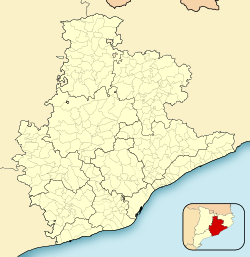Piera
Piera | |
|---|---|
 City hall | |
| Coordinates: 41°31′20″N 1°44′58″E / 41.52222°N 1.74944°E | |
| Country | |
| Community | |
| Province | Barcelona |
| Comarca | Anoia |
| Government | |
| • Mayor | Jordi Madrid Roca (2015)[1] |
| Area | |
| • Total | 57.2 km2 (22.1 sq mi) |
| Elevation | 324 m (1,063 ft) |
| Population (2018)[3] | |
| • Total | 15,362 |
| • Density | 270/km2 (700/sq mi) |
| Demonym(s) | Pierenc, pierenca |
| Website | www |
Piera (Catalan pronunciation: and construction materials. Tourism during the summer months is also relatively important for the local economy.
The FGC railway line R6 from Martorell and Barcelona to Igualada runs through the town, while local roads lead to Capellades and Sant Sadurní d'Anoia.
Notable monuments include the castle of Fontanet. The castle which was restored in 1916 by Ramon de Viala d'Aiguavives, Baron of Almenar is documented in 955 a.c. and now used for private functions.
The sister of the Baron of Almenar, Isabel de Viala d'Aiguavives also financed and patroned the modernist church of
Another Piera relevant monument is the church of Santa Maria, with both Gothic and Roman elements.
Subdivisions
The municipality of Piera includes several outlying villages (barris): these are usually distinguished into the older, traditional settlements (barris antics) and the newer urbanisations which have been developed to cope with the expansion of the municipality (barris nous). Populations are given for 1999, from the Ajuntament de Piera and cited in Història de Piera: the town of Piera (nucli urbà) had a population of 5036 at that date, whereas the total population of the municipality was 8551.
Traditional barris
- El Bedorc (237), on the Anoia river
- Ca n'Aguilera (161)
- Can Cairot (28)
- Can Creixell (2)
- La Fortesa (57), on the Anoia river at the southern point of the municipality
- Sant Jaume Sesoliveres (213)
Newer barris
- Bosc de l'Àliga (88)
- Can Bonastre (490)
- Can Bou (93)
- Can Canals (602)
- Can Claramunt (494)
- Can Martí (222)
- Can Mas (427)
- Can Mata (166)
- Castell de la Ventosa (51)
- La Grua (20)
- Vallbonica (26), on the road to Vallbona d'Anoia
- La Venta i Can Musarro (138)
Demography
| 1900 | 1930 | 1950 | 1970 | 1986 | 2007 |
|---|---|---|---|---|---|
| 2663 | 3474 | 3334 | 3813 | 5215 | 13,652 |
Twin towns
Piera is
 Estepa, Spain
Estepa, Spain
Transportation
Train line connecting Igualada with Barcelona has a stop for boarding on both ways of the line.
Independence declaration
On 30 October 2012, Piera proclaimed itself as a Free Catalan Territory.
References
- Generalitat of Catalonia. Retrieved 2015-11-13.
- Statistical Institute of Catalonia. Retrieved 2015-11-23.
- ^ Municipal Register of Spain 2018. National Statistics Institute.
- Panareda Clopés, Josep Maria; Rios Calvet, Jaume; Rabella Vives, Josep Maria (1989). "Guia de Catalunya", Barcelona: Caixa de Catalunya. (in Spanish) ISBN 84-87135-02-1.
External links
- Official website (in Catalan)
- Government data pages (in Catalan)
| Autoritat del Transport Metropolità Ferrocarrils de la Generalitat de Catalunya | ||||
|---|---|---|---|---|
| Line R6 | ||||
| Barcelona (Plaça d'Espanya) |
↔ | Piera | ↔ | Igualada
|




